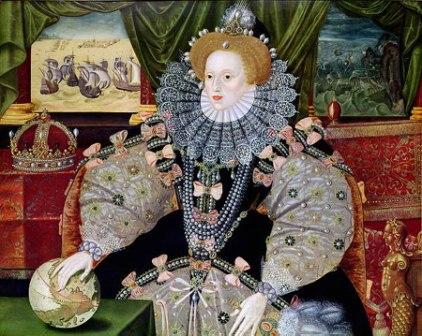Christopher Marlowe's (1564-1593) first play, Tamburlaine The Great tells the story of Timur, a 14th century Turkish warlord. Marlowe portrays the historic figure, "threatening the world with high astounding terms, and scourging kingdoms with his conquering sword." The play was first performed in 1587 by The Admiral's Men, the theatre company of Charles Howard, 1st Earl of Nottingham, Lord High Admiral and maternal relation of Queen Elizabeth I. Tamburlaine was an immediate success, due to the writing, but equally because of the exotic setting. Marlowe, the son of a Canterbury shoemaker, moved to London in time to see it put to the stage (Wagner, 194).
Marlowe's literary contributions, like the man himself, were dark, psychological, and pushed the boundaries of societal expectations and propriety in Elizabethan London. He was charged with atheism, and widely suspected to be a spy before he was killed in a bar brawl (though some conspiracy theorists have called it murder, or a way for Marlowe to stage his own death and then disappear). We know that Marlowe's literary patron was Thomas Walsingham, brother to Queen Elizabeth I's spymaster Francis Walsingham, and that Francis and Christopher were well acquainted, which could have led to his employment as a spy or informant (Wagner, 194). Had he lived in the 17th century, and more specifically under the reign of King Charles II, Marlowe's material and his character would have been far less shocking to the sensibilities of the theatre-goers of London.
 |
| A detail of a portrait of Sir Francis Walsingham, Elizabeth I's spymaster and a likely acquaintance of Marlowe. |
Marlowe's most famous work is The Tragicall History of the Life and Death of Dr. Faustus. According to Logan and Smith, "no Elizabethan play outside the Shakespeare canon has raised more controversy than Doctor Faustus. "(Wagner, 14). In the play, Doctor Faustus learns necromancy from two magicians. In a thirst for knowledge and power, Faustus summons a devil named Mephistopheles, and sells his soul to Lucifer in exchange for 24 years of Mephistopheles doing his bidding on earth. Even if you have not read Doctor Faustus yourself, you can already surmise that no good can come of such an arrangement.
Doctor Faustus was first published in 1604, eleven years after Marlowe's death, but it had been staged much earlier; The Admiral's Men performed it twenty-five times in three years, between October of 1594 and October of 1597. It was probably revived again in 1602 (Chambers, Vol. 3, pages 423-424).
Today I would like to leave you with a dark, twisted visual from Marlowe's play, and thus his mind. This line is spoken by an 'evil angel' (one of Lucifer's followers) :
Now Faustus, let thine eyes with horror stare
Into that vast perpetual torture-house,
There are the furies tossing damned souls
On burning forks. Their bodies broil in lead.
A cautionary tale about faith by a suspected atheist? An example of the psyche of the author? I will let you decide!
Sources:
Wagner, John A. The Historical Dictionary of the Elizabethan World. Print.
(pages 194-195)
Chambers, E.K. The Elizabethan Stage, 4 Volumes. Oxford: Clarendon Press, 1923. Print.
Logan, P. Terence, Smith S. Denzell. The Predecessors of Shakespeare: A Survey and Bibliography of Recent Studies in English Renaissance Drama. University of Nebraska Press, 1973. Print.
For further reading on Christopher Marlowe:
Christopher Marlowe: His Life and Work by A. L. Rowse
Christopher Marlowe and Edward Alleyn by Adam Hart.


